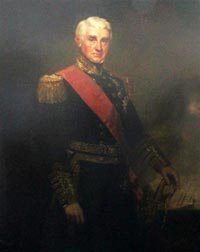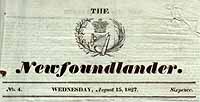
|
Reform Era, 1815-1832 The period from 1815 to 1832 represents a watershed in the legal history of Newfoundland. Between the end of the Napoleonic Wars and the grant of representative government in 1832, the island experienced the end of naval government and the birth of what we now recognize as modern Newfoundland. Fueling this remarkable growth were the massive social and economic changes which the island underwent during the French Revolutionary and Napoleonic wars. From 1793 to 1815 the Newfoundland fishery transformed into a largely resident operation; massive immigration boosted the population dramatically; and new political institutions emerged. Groups such as the Society of Merchants and the Benevolent Irish Society became established and, equally important, in 1807 the island's first newspaper, the Royal Gazette, began publication.
Nourished by these developments, a reform movement arose. Led principally by William Carson and Patrick Morris, this movement revolutionized the nature of politics in St. John's and eventually the entire island. Carson was a physician who emigrated from Scotland in 1808, while Morris arrived from Ireland in 1804 and entered the mercantile trade. They published the first political protest pamphlets in St. John's, attacking the government for abusing individual liberties and demanded that an elected assembly be established. In 1820 the reformers used the Lundrigan-Butler Affair to expand their political base and to place greater pressure on the British government. They formed a committee, complied a petition to London, and sent a representative to present their case before the House of Commons. Throughout 1821-23 they held a series of public meetings to garner support for their cause. Perhaps the most important theme in this period is how law and politics became intertwined. Reformers such as Carson and Morris viewed Newfoundland's legal system as largely to blame for the island's economic problems after 1815. The archaic system of naval government had, it was repeatedly alleged, retarded Newfoundland's development. In particular, the reform movement targeted the system of surrogate courts and the apparent misrule of the naval governors. Patrick Morris argued that the island fully deserved institutions consistent with the needs of a civilized society: the old system of naval government was no longer sustainable in what had become a permanently settled colonial society. Added to this expanding discourse were two important themes: a drive for civil rights, and a reaction against the perceived tyranny of the English fish merchants. Although the former stayed mostly in the political background until 1832, the desire for religious liberties formed a vital ingredient of the early reform movement. Until the mid-1820s the reformers were mostly Irish Catholics who remained outside the traditional circles of power. Like their counterparts in Ireland and Britain, they wanted the British government to repeal the laws restricting Roman Catholicism. Second, with regards to the rhetoric against merchants, the reformers focused on the power of those who monopolized the island's resources yet did not live in Newfoundland. Patrick Morris used the emotional imagery of slavery to depict how the island's people had suffered under the rule of these monopolist merchants. In 1824 the reform movement won a partial victory. The British government passed the Judicature Act which, among other things, abolished the surrogate courts and provided for a charter of incorporation to make town by-laws. A Royal Charter issued in 1825 finally granted Newfoundland official colonial status, with a civil governor and a council. The council included the chief justice, two assistant judges, and the commander of the army garrison; but it was merely an advisory body, appointed by the governor and effectively under his control. When the new governor, Sir Thomas Cochrane, arrived in St. John's he received a warm reception and was lauded in the local press. In January 1826 Cochrane presided over an elaborate public ceremony to mark the opening of the reconstituted supreme court. With the streets jammed with onlookers, a long procession of officials and dignitaries marched from the governor's residence to the court house; an officer in the parade displayed the Royal Charter as salutes were fired by an honour guard and a warship in the harbour; and, to mark the occasion, the Governor pardoned and released most of the prisoners from jail.
Soon after taking office Cochrane held private meetings with merchants and prominent reformers in order to discuss the creation of a local government in St. John's. However, the process abruptly ground to a halt in 1826 when a bloc of leading merchants opposed the proposal for a charter of incorporation. Merchants in St. John's had, in fact, never fully backed the early reform movement, and now a conservative faction publicly objected to the establishment of a town council. This split between conservative and reformist parties inhibited further constitutional reforms; at the end of 1826 representative government still remained a rather distant goal. In 1827-28 two factors transformed the reform movement in Newfoundland. First, the British government announced the imposition of new duties on imports into the colony. Such a move contravened the traditional exemption of the fishery from taxation and would cut directly into the operations of the St. John's merchants. It also united the fractious merchant interests against the proposed tax. Using George Robinson, an MP in the House of Commons, the St. John's Chamber of Commerce registered its protest in the British parliament. Second, a broad coalition of reformers and merchants emerged to campaign against "taxation without representation." This movement was made possible by the independent newspapers—in particular the Public Ledger and the Newfoundlander—published in St. John's. As a leading force in the reform movement, the press in Newfoundland exerted a formative influence over how public discourse evolved. From 1828 to 1832 the reform movement grew into a broad-based organization centred on the aim of gaining representative government in Newfoundland. With representatives from outport communities and delegations in London, the movement became increasingly public, holding open-air meetings at which hundreds of people signed petitions. Using a variety of arguments—such as potential savings for the British government—the reformers gained support in parliament and undermined the governor and the Colonial Office. Faced with the shrewd maneuvering and beset with domestic worries, the British government finally relented in early 1832 and granted Newfoundland representative government. In less than a generation, then, the island had undergone a remarkable constitutional transformation from naval government to the beginnings of a modern legal system. © 2000, Jerry Bannister Cochrane image updated April 2016 |
|||||||||||||||||
 |
||||||||||||||||||


